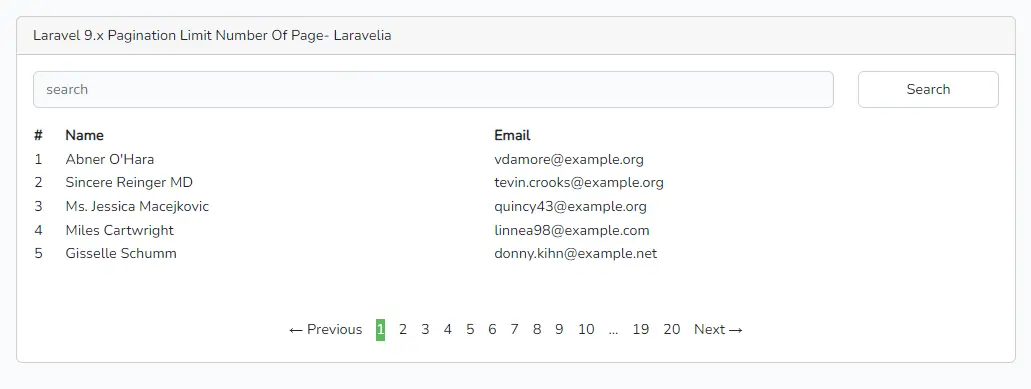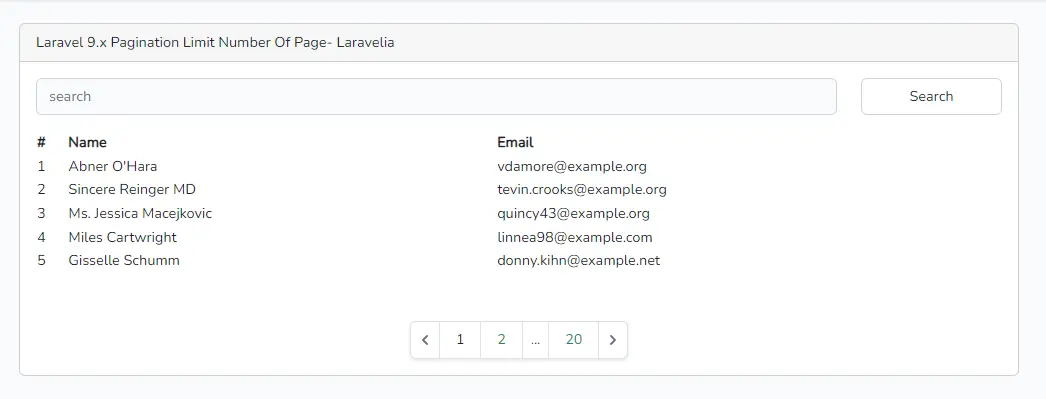Sometimes we need to show the limited amount of links on each side of laravel pagination. So in this tutorial, I will show you how to limit amount of links shown with Laravel pagination. We can do it very easily with our custom code.
I will use users table to generate pagination and then we will change the limit number of pagination in laravel. So if you do not understand how to do laravel pagination links limit then this laravel 9 pagination limit number of pages tutorial is for you. See the preview from below image that what we are going to make:
Laravel Pagination Before Limit Number Of Page

Laravel Pagination After Limit Number Of Page

Step 1: Install Laravel
First of all, we need to get a fresh Laravel 9 version application using the bellow command, So open your terminal OR command prompt and run the bellow command to start laravel pagination limit number of pages.
composer create-project laravel/laravel example-app
Step 2: Connect Database
After successfully installing the laravel app and then configuring the database setup. We will open the ".env" file and change the database name, username and password in the env file to create laravel 9 pagination limit number of pages.
.env
DB_CONNECTION=mysql
DB_HOST=127.0.0.1
DB_PORT=3306
DB_DATABASE=Enter_Your_Database_Name
DB_USERNAME=Enter_Your_Database_Username
DB_PASSWORD=Enter_Your_Database_Password
Read also: Load More Data On Button Click Using JQuery Laravel
Step 3: Create Migration and Model
In this step, we need to create users table and model. then we need to run a migration. so let's change the files.
database/migrations/create_users_table.php
<?php
use Illuminate\Database\Migrations\Migration;
use Illuminate\Database\Schema\Blueprint;
use Illuminate\Support\Facades\Schema;
return new class extends Migration
{
/**
* Run the migrations.
*
* @return void
*/
public function up()
{
Schema::create('users', function (Blueprint $table) {
$table->id();
$table->string('name');
$table->string('email')->unique();
$table->timestamp('email_verified_at')->nullable();
$table->string('password');
$table->string('status')->nullable()->default(false);
$table->rememberToken();
$table->timestamps();
});
}
/**
* Reverse the migrations.
*
* @return void
*/
public function down()
{
Schema::dropIfExists('users');
}
};
Now update the user model by replacing it with the below code:
app/Models/User.php
<?php
namespace App\Models;
use Illuminate\Contracts\Auth\MustVerifyEmail;
use Illuminate\Database\Eloquent\Factories\HasFactory;
use Illuminate\Foundation\Auth\User as Authenticatable;
use Illuminate\Notifications\Notifiable;
class User extends Authenticatable
{
use HasFactory, Notifiable;
/**
* The attributes that are mass assignable.
*
* @var array
*/
protected $fillable = [
'name', 'email', 'password'
];
/**
* The attributes that should be hidden for arrays.
*
* @var array
*/
protected $hidden = [
'password', 'remember_token',
];
/**
* The attributes that should be cast to native types.
*
* @var array
*/
protected $casts = [
'email_verified_at' => 'datetime',
];
}
Now you have to run this migration by following the command:
php artisan migrate
Now update the seeder class like below:
Database\Seeders\DatabaseSeeder.php
<?php
namespace Database\Seeders;
use App\Models\Post;
use App\Models\User;
use Illuminate\Support\Str;
use Illuminate\Database\Seeder;
use Illuminate\Database\Console\Seeds\WithoutModelEvents;
class DatabaseSeeder extends Seeder
{
public function run()
{
for ($i=0; $i < 100; $i++) {
User::create([
'name' => fake()->name(),
'email' => fake()->unique()->safeEmail(),
'email_verified_at' => now(),
'password' => '$2y$10$92IXUNpkjO0rOQ5byMi.Ye4oKoEa3Ro9llC/.og/at2.uheWG/igi',
'remember_token' => Str::random(10),
'status' => $i % 2 === 0 ? 'active' : 'inactive'
]);
}
}
}
Now run the below command to insert some dummy data.
php artisan db:seed
Read also: Laravel 9 Cursor Pagination Example
Step 4: Create Route
Here, we need to add one more route to display the users data with laravel pagination links limit. so let's add that route in the web.php file.
routes/web.php
<?php
use Illuminate\Support\Facades\Route;
use App\Http\Controllers\TutorialController;
/*
|--------------------------------------------------------------------------
| Web Routes
|--------------------------------------------------------------------------
|
| Here is where you can register web routes for your application. These
| routes are loaded by the RouteServiceProvider within a group which
| contains the "web" middleware group. Now create something great!
|
*/
Route::get('/', [TutorialController::class,'index']);
Step 5: Create Controller
Here, we need to add the index() method for fetching users data for how to limit amount of links shown with laravel pagination in TutorialController. so let's add like as below:
app/Http/Controllers/TutorialController.php
<?php
namespace App\Http\Controllers;
use App\Models\User;
use Illuminate\Http\Request;
use Illuminate\Contracts\Database\Eloquent\Builder;
class TutorialController extends Controller
{
public function index(Request $request)
{
$users = User::query()
->paginate(5);
return view('welcome',compact('users'));
}
}
Step 6: Create Blade file
In this step, we need to create a welcome blade file and update file. so let's change it.
resources/views/welcome.blade.php
@extends('layouts.app')
@push('style')
<link href="https://maxcdn.bootstrapcdn.com/font-awesome/4.7.0/css/font-awesome.min.css" rel="stylesheet">
<style type="text/css">
.my-active span{
background-color: #5cb85c !important;
color: white !important;
border-color: #5cb85c !important;
}
ul.pager>li {
display: inline-flex;
padding: 5px;
}
</style>
@endpush
@section('content')
<div class="container">
<div class="row justify-content-center">
<div class="col-md-8">
<div class="card">
<div class="card-header">Laravel 9.x Pagination Limit Number Of Page- Laravelia</div>
<div class="card-body">
<table style="width: 100%">
<thead>
<th>#</th>
<th>Name</th>
<th>Email</th>
</thead>
<tbody>
@foreach($users as $user)
<tr>
<td>{{ $loop->index + 1 }}</td>
<td>{{ $user->name }}</td>
<td>{{ $user->email }}</td>
</tr>
@endforeach
</tbody>
</table>
<center class="mt-5">
{{ $users->withQueryString()->links('pagination.custom') }}
</center>
</div>
</div>
</div>
</div>
</div>
@endsection
Now create an app blade file and update it like this:
resources/views/layouts/app.blade.php
<!doctype html>
<html lang="{{ str_replace('_', '-', app()->getLocale()) }}">
<head>
<meta charset="utf-8">
<meta name="viewport" content="width=device-width, initial-scale=1">
<!-- CSRF Token -->
<meta name="csrf-token" content="{{ csrf_token() }}">
<title>{{ config('app.name', 'Laravel') }}</title>
<!-- Tailwindcss -->
<script src="https://cdn.tailwindcss.com"></script>
<!-- Scripts -->
@vite(['resources/sass/app.scss', 'resources/js/app.js'])
@stack('style')
</head>
<body>
<div id="app">
<nav class="navbar navbar-expand-md navbar-light bg-white shadow-sm">
<div class="container">
<a class="navbar-brand" href="{{ url('/') }}">
Laravelia
</a>
<button class="navbar-toggler" type="button" data-bs-toggle="collapse" data-bs-target="#navbarSupportedContent" aria-controls="navbarSupportedContent" aria-expanded="false" aria-label="{{ __('Toggle navigation') }}">
<span class="navbar-toggler-icon"></span>
</button>
<div class="collapse navbar-collapse" id="navbarSupportedContent">
<!-- Left Side Of Navbar -->
<ul class="navbar-nav me-auto">
</ul>
<!-- Right Side Of Navbar -->
<ul class="navbar-nav ms-auto">
<!-- Authentication Links -->
@guest
@if (Route::has('login'))
<li class="nav-item">
<a class="nav-link" href="{{ route('login') }}">{{ __('Login') }}</a>
</li>
@endif
@if (Route::has('register'))
<li class="nav-item">
<a class="nav-link" href="{{ route('register') }}">{{ __('Register') }}</a>
</li>
@endif
@else
<li class="nav-item dropdown">
<a id="navbarDropdown" class="nav-link dropdown-toggle" href="#" role="button" data-bs-toggle="dropdown" aria-haspopup="true" aria-expanded="false" v-pre>
{{ Auth::user()->name }}
</a>
<div class="dropdown-menu dropdown-menu-end" aria-labelledby="navbarDropdown">
<a class="dropdown-item" href="{{ route('logout') }}"
onclick="event.preventDefault();
document.getElementById('logout-form').submit();">
{{ __('Logout') }}
</a>
<form id="logout-form" action="{{ route('logout') }}" method="POST" class="d-none">
@csrf
</form>
</div>
</li>
@endguest
</ul>
</div>
</div>
</nav>
<main class="py-4">
@yield('content')
</main>
</div>
@stack('script')
</body>
</html>
Now create a custom pagination blade file and update it like this:
resources/views/pagination/custom.blade.php
@if ($paginator->hasPages())
<ul class="pagination pagination">
@if ($paginator->onFirstPage())
<li class="disabled"><span>«</span></li>
@else
<li><a href="{{ $paginator->previousPageUrl() }}" rel="prev">«</a></li>
@endif
@if($paginator->currentPage() > 3)
<li class="hidden-xs"><a href="{{ $paginator->url(1) }}">1</a></li>
@endif
@if($paginator->currentPage() > 4)
<li><span>...</span></li>
@endif
@foreach(range(1, $paginator->lastPage()) as $i)
@if($i >= $paginator->currentPage() - 2 && $i <= $paginator->currentPage() + 2)
@if ($i == $paginator->currentPage())
<li class="active"><span>{{ $i }}</span></li>
@else
<li><a href="{{ $paginator->url($i) }}">{{ $i }}</a></li>
@endif
@endif
@endforeach
@if($paginator->currentPage() < $paginator->lastPage() - 3)
<li><span>...</span></li>
@endif
@if($paginator->currentPage() < $paginator->lastPage() - 2)
<li class="hidden-xs"><a href="{{ $paginator->url($paginator->lastPage()) }}">{{ $paginator->lastPage() }}</a></li>
@endif
@if ($paginator->hasMorePages())
<li><a href="{{ $paginator->nextPageUrl() }}" rel="next">»</a></li>
@else
<li class="disabled"><span>»</span></li>
@endif
</ul>
@endif
Read also: How To Create Pagination From Laravel Collection?
Ok, now we are ready to go and test laravel pagination limit number of pages tutorial. So let's run the project using this command:
php artisan serve
Now you can test our application by visiting the below URL:
URL
Conclusion
Now we know laravel pagination limit number of pages. Hope this laravel 9 pagination limit number of pages tutorial will help you to create laravel pagination links limit.
